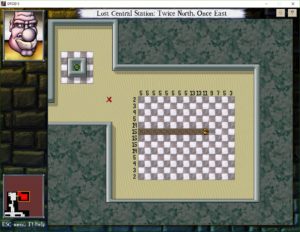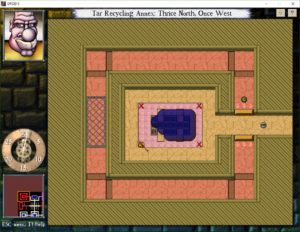The Second Sky: Arky Rooms
I’m in a position in The Second Sky that’s more familiar from JRPGs than from puzzle games: very near the end, but holding off on completing the game because I want to finish more side-quests first. In a RPG, there are usually practical justifications for this: completing those last few quests could give you items or other boosts that help you against the final boss. At the very least, you can expect to get a little extra XP in their pursuit. That doesn’t apply to DROD puzzles. Neither will the bonus puzzles become unavailable after I win. Nonetheless, it is lodged in my brain that this is the proper order to do things in. Side-quests, then victory, and then, because this is DROD, going back to hunt for the secrets I missed and unlock the Mastery area.
One thing I discovered in my last session: a secondary office for the new First Archivist, who Beethro calls “Arky” to distinguish him from the First Archivist who attacked the surface, containing a note explaining his puzzle design MO. I should note that Beethro and Arky are reconciled now; towards the end of the story, Beethro finally gives him the apology that was all he wanted all along. Beethro’s really grown as a person over the course of this episode. But even after he’s your friend, there are still “Arky rooms” to contend with. The “Inventory” room back at the train hub even tracks them as a special category.
Arky rooms are always secret rooms, and thus optional. Their hallmark is a note from Arky describing what makes the room impossible to solve. An actually impossible room is trivial to make, but the point is that these rooms look like puzzles, and this tricks delvers into trying to solve them. In fact, the rooms are perfectly solvable, and Arky’s explanations of why they’re not contain hidden false assumptions. The effect is to make Arky seem humorously incompetent, and this is heightened by the way that the notes describing tricking delvers have been left around for delvers to find.
There’s one other purpose for the notes: misdirection. If it weren’t for the notes, the player might not notice that the room is “impossible”. There’s one note that describes how opening the room’s tar gate requires clearing three invulnerable 2×2 bocks of tarstuff with only one powder keg. I read that note on entering the room, and sure enough: the room has blocks of gel, tar, and mud. The sole powder keg could be placed between two of them, but had to miss the third. I assert that it is the effect of the note that it took me as long as I did to realize: Hey, wait a minute, a 2×2 block of mud isn’t invulnerable! I can clear that with my sword! It was like the room’s punch line. Arky seems all the more incompetent for making such a stupid mistake, but then, through the note, he managed to pass his stupidity on to me. Perhaps he’s cleverer than he seems?
The note in the secondary office says that the main trick behind his puzzles is to make ones that he personally can’t solve. If someone else finds a solution, he pretends that it’s what he had in mind all along. If no one finds a solution, it just makes him seem cleverer than everyone else. And it’s got me thinking: This actually might not be a bad approach for puzzle design in DROD. Obviously you want to not actually release puzzles that no one has been able to solve, but the “Let someone try to solve something I think is impossible” part? DROD players have proven their ability to find solutions that the designers didn’t think of. That’s how we got the kill-the-Slayer Achievement in Journey to Rooted Hold. Or consider taking the same approach with yourself as the player: design a puzzle, then remove something that the solution to the puzzle relies on and try to solve it anyway. I suspect that some similar process is behind all the theme-and-variations puzzle designs in this game. I mentioned a pair of levels called Easy Way and Hard Way. I have since discovered that it continues into Harder Way and Hardest Way, four sets of the same puzzle designs with the solution to each made impossible in the next.
 Comments(5)
Comments(5)

